Study on the Strength Characteristics and Microscopic Structure of Artificial Structural Loess
Abstract
1. Introduction
2. Materials and Methods
2.1. Test Materials
2.2. Sample Preparation
2.3. Test Method
2.3.1. Triaxial Shear Test
2.3.2. Microscopic Test
3. Results and Analysis
3.1. Analysis of Stress–Strain Curve
3.2. Analysis of Peak Strength Curve
3.3. Analysis of Shear Strength Index
3.4. Analysis of Mineral Composition in Loess
3.5. Analysis of Microstructure in Loess
3.6. Analysis of Pore Distribution in Loess
3.6.1. Pore Division of Structural Loess
3.6.2. Quantitative Analysis of Pore Distribution Characteristics
3.6.3. Analysis of Macro- and Microcorrelation
4. Conclusions
- The combined effect of the moisture content, pressure, and additive changes the stress–strain relationship of the artificial structural loess. Under the same pressure, when the cement dosage remains constant, the curve of the sample gradually moves downward with the increasing moisture content, and its breaking strength is negatively correlated with the moisture content. Under the same moisture content, the curve of the sample gradually increases with the increasing cement dosage, and its breaking strength shows a positive correlation with the cement dosage.
- The standard deviation of the peak strength for W16-Y2.0C2.0 is the smallest under various confining pressures, with 50 kPa being 6.481, 100 kPa being 7.676, and 200 kPa being 4.912. The minimum standard deviations of the cohesive inner friction angle are 2 kPa and 0.2°, respectively, corresponding to W16-Y2.0C2.0, indicating that the cohesive inner friction angle of W16-Y2.0C2.0 is the closest to that of the undisturbed sample. W16-Y2.0C2.0 is the optimal structural loess, and its structural strength is most similar to that of the undisturbed loess.
- The scatter patterns of the undisturbed loess and W16-Y2.0C2.0 are roughly similar. The characteristic peaks of cement and salt are not displayed in the diffraction pattern of W16-Y2.0C2.0. In addition, further quantitative analysis found that the differences in the mineral content between A and W16-Y2.0C2.0 are obtained. The stone salt is not detected in A, and the amphibole is not detected in W16-Y2.0C2.0.
- There exist many white cementing substances at the particle contact point of W16-Y2.0C2.0, which cause clay material to aggregate at the particle contact point, increasing the area and cohesion of the contact point. Some particles exhibit agglomeration, especially between small particles, which may be due to the increased electrostatic attraction or other forces between particles caused by the action of salt particles, resulting in particle aggregation, thus making the soil sample have similar structural strength and stability to those of the undisturbed soil.
- The pore distribution curve of the structural loess W16-Y2.0C2.0 has three peaks and is divided into four types of pores, including micropores (≤0.02 μm), small pores (0.02~0.21 μm), medium pores (0.21~13.5 μm), and large pores (≥13.5 μm). When the pressure increases from 50 kPa to 200 kPa, micropores increase by 4.67%, small pores increase by 4.97%, medium pores decrease by 2.4%, and large pores decrease by 7.24%. The trend of pore structure changes in W16-Y2.0C2.0 under pressure is similar to that of A.
- This study is based on laboratory standard conditions, without considering complex environmental factors such as wet–dry cycles, freeze–thaw effects, and dynamic loads that may exist in actual engineering. In the future, research will be conducted on the strength degradation mechanism of artificial structural loess under wet–dry cycles, freeze–thaw cycles, and chemical erosion. Although W16-Y2.0C2.0 exhibits strength characteristics similar to those of the undisturbed loess in the laboratory, considering the heterogeneity of the soil on site, fluctuations in moisture content, and dynamic changes in load, it is necessary to verify its universality.
Author Contributions
Funding
Data Availability Statement
Conflicts of Interest
References
- Li, Y.; Shi, W.; Aydin, A.; Beroya-Eitner, M.A.; Gao, G. Loess genesis and worldwide distribution. Earth-Sci. Rev. 2020, 201, 102947. [Google Scholar] [CrossRef]
- Crouvi, O.; Sun, J.; Rousseau, D.D.; Muhs, D.R.; Zárate, M.; Marx, S. Loess Records. Ref. Mod. Earth Syst. Environ. Sci. 2024. [Google Scholar] [CrossRef]
- Li, G.; Yan, Z.; Song, Y.; Fitzsimmons, K.E.; Yi, S.; Kang, S.; Chen, F. A comprehensive dataset of luminescence chronologies and environmental proxy indices of loess-paleosol deposits across Asia. NPJ Clim. Atmos. Sci. 2024, 7, 7. [Google Scholar] [CrossRef]
- Wang, L.; Liu, Q.; Li, X.A.; Qin, B.; Hong, B.; Shi, J. Effect of nanosilica on the hydrological properties of loess and the microscopic mechanism. Sci. Rep. 2024, 14, 13692. [Google Scholar] [CrossRef]
- Lone, A.M.; Sharma, S.; Achyuthan, H.; Shukla, A.D.; Shah, R.A.; Sangode, S.J.; AA, F. Climatic implications of late Holocene loess and intervening paleosols, Southern Zanskar range, northwestern Himalaya. Phys. Geogr. 2023, 44, 287–306. [Google Scholar] [CrossRef]
- Neina, D.; Mureithi, S.M.; Van Ranst, E. Soil System Status and Issues in the Global South. In Sustainable Soil Systems in Global South; Springer Nature: New York, NY, USA, 2024; pp. 83–112. [Google Scholar]
- Li, G.Y.; Zhan, L.T.; Hu, Z.; Chen, Y.M. Effects of particle gradation and geometry on the pore characteristics and water retention curves of granular soils: A combined DEM and PNM investigation. Granul. Matter 2021, 23, 9. [Google Scholar] [CrossRef]
- Schlüter, S.; Sammartino, S.; Koestel, J. Exploring the relationship between soil structure and soil functions via pore-scale imaging. Geoderma 2020, 370, 114370. [Google Scholar] [CrossRef]
- Cui, C.; Liang, Z.; Xu, C.; Xin, Y.; Wang, B. Analytical solution for horizontal vibration of end-bearing single pile in radially heterogeneous saturated soil. Appl. Math. Model. 2023, 116, 65–83. [Google Scholar] [CrossRef]
- Yan, X.; Xu, Q.; Deng, M.; Sun, Y.; He, X.; Dong, S.; Zhou, Y. Investigation on the solidification effect and mechanism of loess utilizing magnesium oxysulfate cement as a curing agent. Sci. Total Environ. 2024, 951, 175214. [Google Scholar] [CrossRef]
- Scheuermann Filho, H.C.; Venson, G.I.; Centofante, R.; Festugato, L. Discussion of “Analysis and Optimization of Tensile Strength for Loess Stabilized by Calcium Carbide Residue”. J. Mater. Civ. Eng. 2025, 37, 07024009. [Google Scholar] [CrossRef]
- Chen, H.; Li, H.; Jiang, Y.; Yu, Q.; Yao, M.; Shan, W. Feasibility study on artificial preparation of structured loess. Geosci. Lett. 2022, 9, 21. [Google Scholar] [CrossRef]
- Guo, S.; Zhang, H.; Bi, Y.; Zhang, J. Mechanical experiment and microstructural characteristics of water glass solidified loess. Bull. Eng. Geol. Environ. 2024, 83, 441. [Google Scholar] [CrossRef]
- Cui, C.; Qi, Y.; Meng, K.; You, Z.; Liang, Z.; Xu, C. A new analytical solution for horizontal vibration of floating pile in saturated soil based on FSSP method. Soil Dyn. Earthq. Eng. 2024, 187, 108960. [Google Scholar] [CrossRef]
- Chen, C.L.; Juan, F.; Luo, A.Z.; Shao, S.J. Study of Artificial Structural Loess under the True Triaxial Tests. Adv. Mat. Res. 2013, 671, 343–348. [Google Scholar] [CrossRef]
- Zuo, L.; Lyu, B.; Xu, L.; Li, L. The influence of salt contents on the compressibility of remolded loess soils. Bull. Eng. Geol. Environ. 2022, 81, 185. [Google Scholar] [CrossRef]
- Xue, Z.; Zhang, Y.; Luo, J.; Yan, C.; Emmanuel, M.; Jia, X. Analysis of compressive strength, durability properties, and micromechanisms of solidified loess using industrial solid waste: Slag–white mud–calcium carbide residue. J. Build. Eng. 2024, 84, 108511. [Google Scholar] [CrossRef]
- Chang, J.; Li, J.; Wang, Y.; Zhang, H. Mechanical characteristics and microstructural changes in phosphogypsum-cement-lime composite modified loess. Case Stud. Constr. Mater. 2024, 21, e03881. [Google Scholar] [CrossRef]
- Zhang, Y.; Song, Z.; Chen, H.; Ruan, L.; He, S. Experimental study on collapsible and structural characteristics of artificially prepared loess material. Sci. Rep. 2023, 13, 4113. [Google Scholar] [CrossRef]
- Bao, L.; Wei, F. Macroscopic and microscopic analysis of the effects of moisture content and dry density on the strength of loess. Sci. Prog. 2024, 107, 00368504241261592. [Google Scholar] [CrossRef]
- Yan, R.; Huang, Q.; Peng, J.; Li, R.; Chen, L.; Zhang, Y. Influence of physical properties and shear rate on static liquefaction of saturated loess. Eng. Geol. 2024, 341, 107699. [Google Scholar] [CrossRef]
- Ma, J.; Qiu, Y.; Gao, Y.; An, Y.; Duan, Z.; Li, S. Effects of Sample Preparation Methods on Permeability and Microstructure of Remolded Loess. Water 2023, 15, 3469. [Google Scholar] [CrossRef]
- Nan, J.; Peng, J.; Zhu, F.; Ma, P.; Liu, R.; Leng, Y.; Meng, Z. Shear behavior and microstructural variation in loess from the Yan’an area, China. Eng. Geol. 2021, 280, 105964. [Google Scholar] [CrossRef]
- Li, Z.; Qi, Z.; Qi, S.; Zhang, L.; Hou, X. Microstructural changes and micro–macro-relationships of an intact, compacted and remolded loess for land-creation project from the Loess Plateau. Environ. Earth Sci. 2021, 80, 593. [Google Scholar] [CrossRef]
- Jiang, M.; Zhang, F.; Hu, H.; Cui, Y.; Peng, J. Structural characterization of natural loess and remolded loess under triaxial tests. Eng. Geol. 2014, 181, 249–260. [Google Scholar] [CrossRef]
- Yao, W.; Li, X.A.; Zhang, N.; Ren, Y.; Shi, J.; Zhang, C.; Hao, Z. A feasible method for evaluating the uniformity of remolded loess samples with shear strength. Buildings 2023, 13, 145. [Google Scholar] [CrossRef]
- Qi, Z.; Li, Z. The influence of overburden stress and molding water content on the microstructure of remolded loess. Sustainability 2023, 15, 12401. [Google Scholar] [CrossRef]
- GB/T 50123-2019; Standard for Geotechnical Testing Method. Construction Ministry of PRC: Beijing, China, 2019.
- Zhang, Y.; Zhang, Z.; Hu, W.; Zhang, Y.; Shi, G.; Wang, Y. Shear Strength of Loess in the Yili Region and Corresponding Degradation Mechanisms under Different Cycling Modes. Water 2023, 15, 3382. [Google Scholar] [CrossRef]
- Shah, S.S.A.; Turrakheil, K.S.; Naveed, M. Impact of Wetting and Drying Cycles on the Hydromechanical Properties of Soil and Implications on Slope Stability. Atmosphere 2024, 15, 1368. [Google Scholar] [CrossRef]
- Haeri, S.M.; Khosravi, A.; Garakani, A.A.; Ghazizadeh, S. Effect of soil structure and disturbance on hydromechanical behavior of collapsible loessial soils. Int. J. Geomech. 2017, 17, 04016021. [Google Scholar] [CrossRef]
- Chen, Y.; Dong, M.; Cheng, C.; Han, J.; Zhao, Y.; Jia, P. Experimental and analytical study on the bearing capacity of caisson foundation subjected to V-H combined load. Mar. Georesour. Geotechnol. 2025, 1–13. [Google Scholar] [CrossRef]
- Yang, M.; Cen, N.; Wang, Z.; Huang, B.; Lin, J.; Jiang, F.; Zhang, Y. Study of the Shear Strength Model of Unsaturated Soil in the Benggang Area of Southern China. Water 2024, 16, 3528. [Google Scholar] [CrossRef]
- Liu, L.; Yao, Y.; Zhang, L.; Wang, X. Study on the mechanical properties of modified rammed earth and the correlation of influencing factors. J. Clean. Prod. 2022, 374, 134042. [Google Scholar] [CrossRef]
- Stockton, E.; Leshchinsky, B.A.; Olsen, M.J.; Evans, T.M. Influence of both anisotropic friction and cohesion on the formation of tension cracks and stability of slopes. Eng. Geol. 2019, 249, 31–44. [Google Scholar] [CrossRef]
- Ravindran, S.; Gratchev, I. Effect of water content on apparent cohesion of soils from landslide sites. Geotechnics 2022, 2, 385–394. [Google Scholar] [CrossRef]
- Prokes, R.; Jezerska, L.; Gelnar, D.; Zegzulka, J.; Zidek, M. Inner friction and flowability of clay powder depend on particle moisture, size and normal stress. Powder Technol. 2024, 446, 120184. [Google Scholar] [CrossRef]
- Moretti, L.; Natali, S.; Tiberi, A.; D’Andrea, A. Proposal for a methodology based on xrd and sem-eds to monitor effects of lime-treatment on clayey soils. Appl. Sci. 2020, 10, 2569. [Google Scholar] [CrossRef]
- Barman, D.; Dash, S.K. Stabilization of expansive soils using chemical additives: A review. J. Rock Mech. Geotech. Eng. 2022, 14, 1319–1342. [Google Scholar] [CrossRef]
- Wei, Y.Z.; Yao, Z.H.; Chong, X.L.; Zhang, J.H.; Zhang, J. Microstructure of unsaturated loess and its influence on strength characteristics. Sci. Rep. 2022, 12, 1502. [Google Scholar] [CrossRef]
- Jaffar, S.T.A.; Chen, X.; Bao, X.; Raja, M.N.A.; Abdoun, T.; El-Sekelly, W. Data-driven intelligent modeling of unconfined compressive strength of heavy metal-contaminated soil. J. Rock Mech. Geotech. Eng. 2025, 17, 1801–1815. [Google Scholar] [CrossRef]
- Yu, C.; He, C.B.; Li, Z.; Li, Y.A.; Li, Y.; Sun, Y.L.; Wu, Y.Q. Disintegration characteristics and mechanism of red clay improved by steel slag powder. Constr. Build. Mater. 2024, 444, 137873. [Google Scholar] [CrossRef]
- Chen, Y.; Zhang, R.; Zi, J.; Han, J.; Liu, K. Evaluation of the treatment variables on the shear strength of loess treated by microbial induced carbonate precipitation. J. Mt. Sci. 2025, 22, 1075–1086. [Google Scholar] [CrossRef]
- Shrestha, S.; Wang, B.; Dutta, P. Nanoparticle processing: Understanding and controlling aggregation. Adv. Colloid Interface Sci. 2020, 279, 102162. [Google Scholar] [CrossRef] [PubMed]
- Zhao, X.; Cui, Y.; Zhang, R.; Tian, G.; Satyanaga, A.; Zhai, Q. Experimental investigation of the collapsibility of loess subjected to water invasion. Bull. Eng. Geol. Environ. 2024, 83, 33. [Google Scholar] [CrossRef]
- Basham, M.R.; Cerato, A.B.; Tabet, W.E. Using Fractal Geometry Theory to Quantify Pore Structure Evolution and Particle Morphology of Stabilized Kaolinite. J. Mater. Civ. Eng. 2024, 36, 04024247. [Google Scholar] [CrossRef]
- Xu, P.; Qian, H.; Chen, J.; Wang, L.; Abliz, X.; He, X.; Liu, Y. New insights into microstructure evolution mechanism of compacted loess and its engineering implications. Bull. Eng. Geol. Environ. 2023, 82, 36. [Google Scholar] [CrossRef]
- Zhang, J.; Jia, M.; Jiang, T.; Kato, S.; Sun, D.A.; Gao, Y.; Yang, Z. Dynamic deformation characteristics and microscopic analysis of xanthan gum-treated silty soil during wetting process. J. Rock Mech. Geotech. Eng. 2025, 17, 1149–1162. [Google Scholar] [CrossRef]

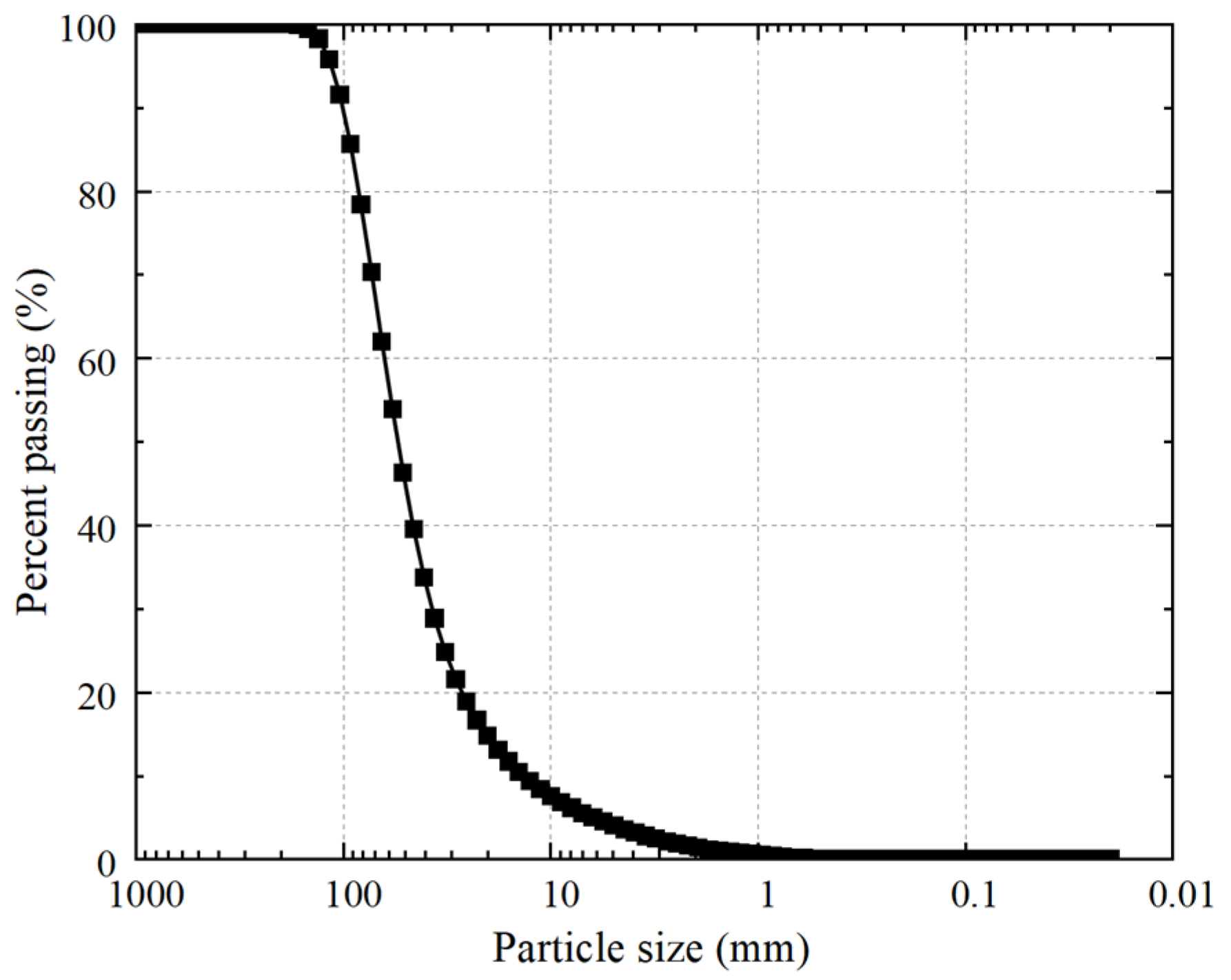


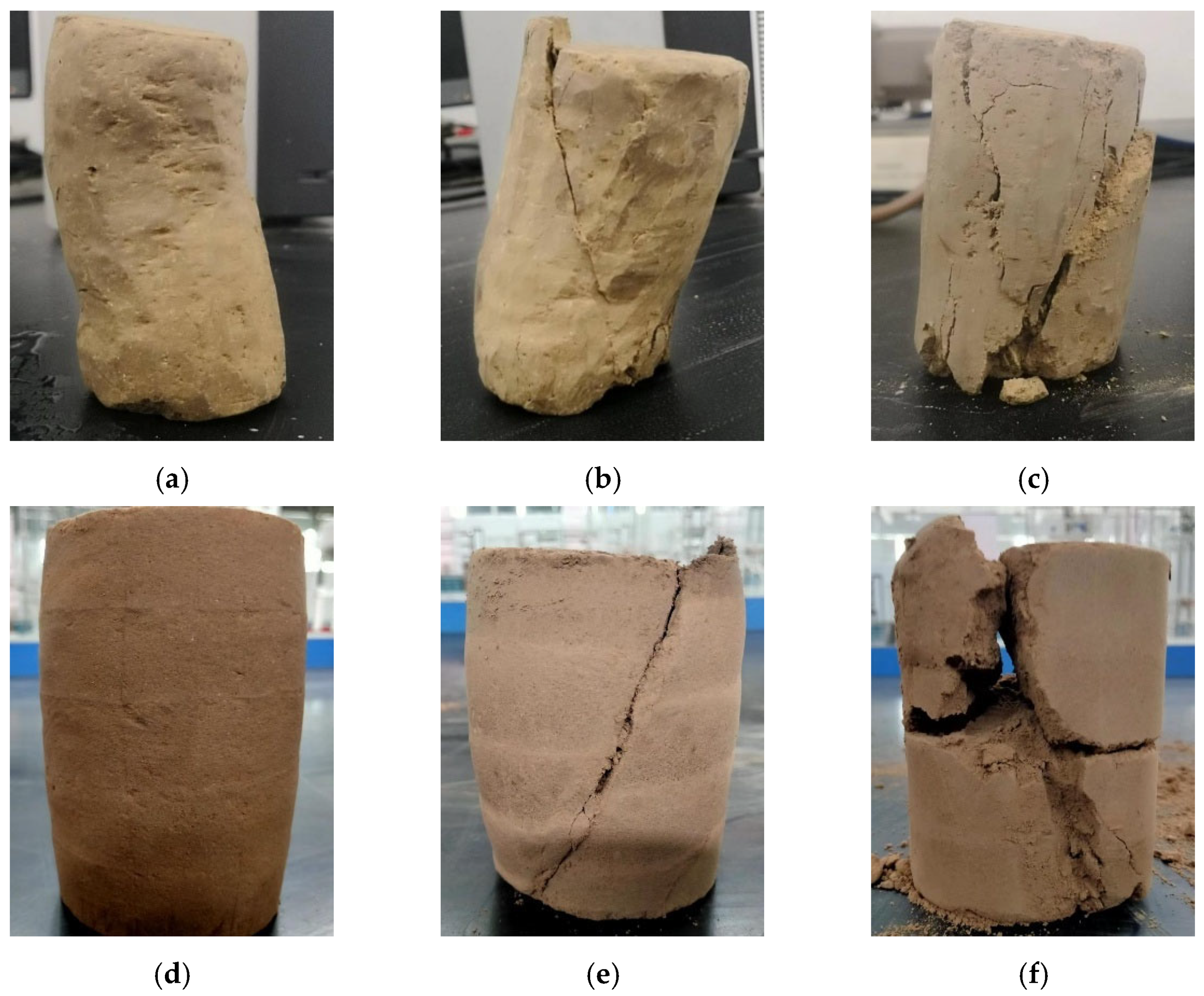
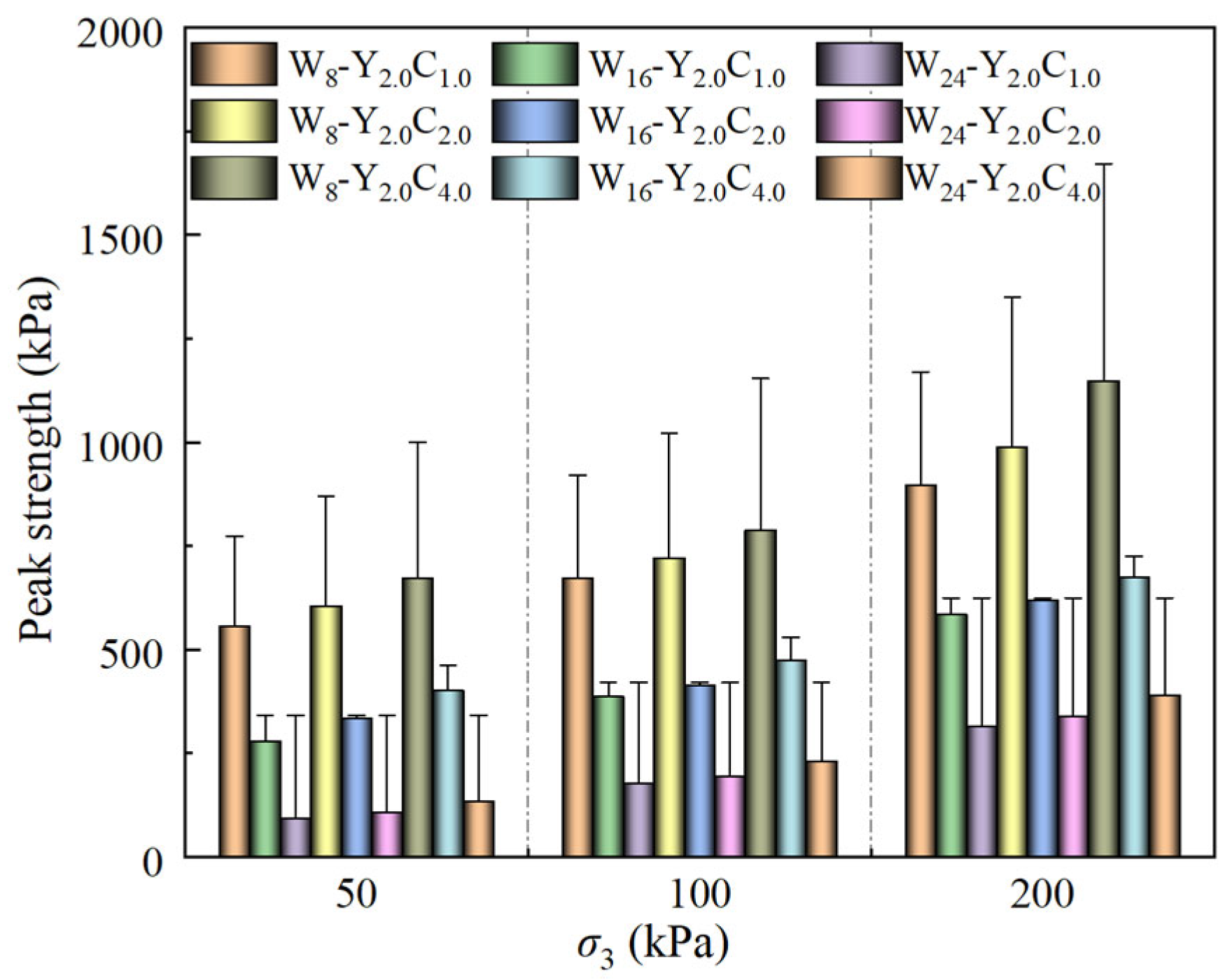
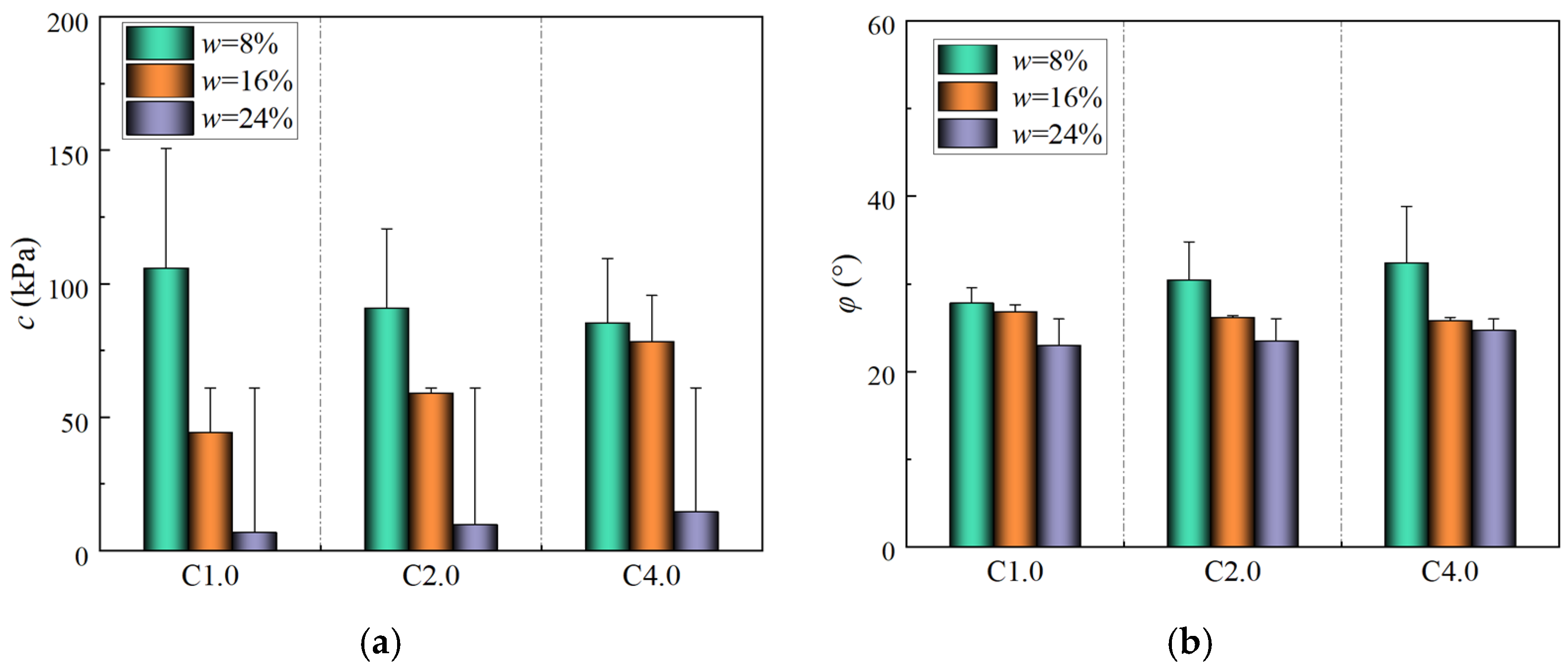

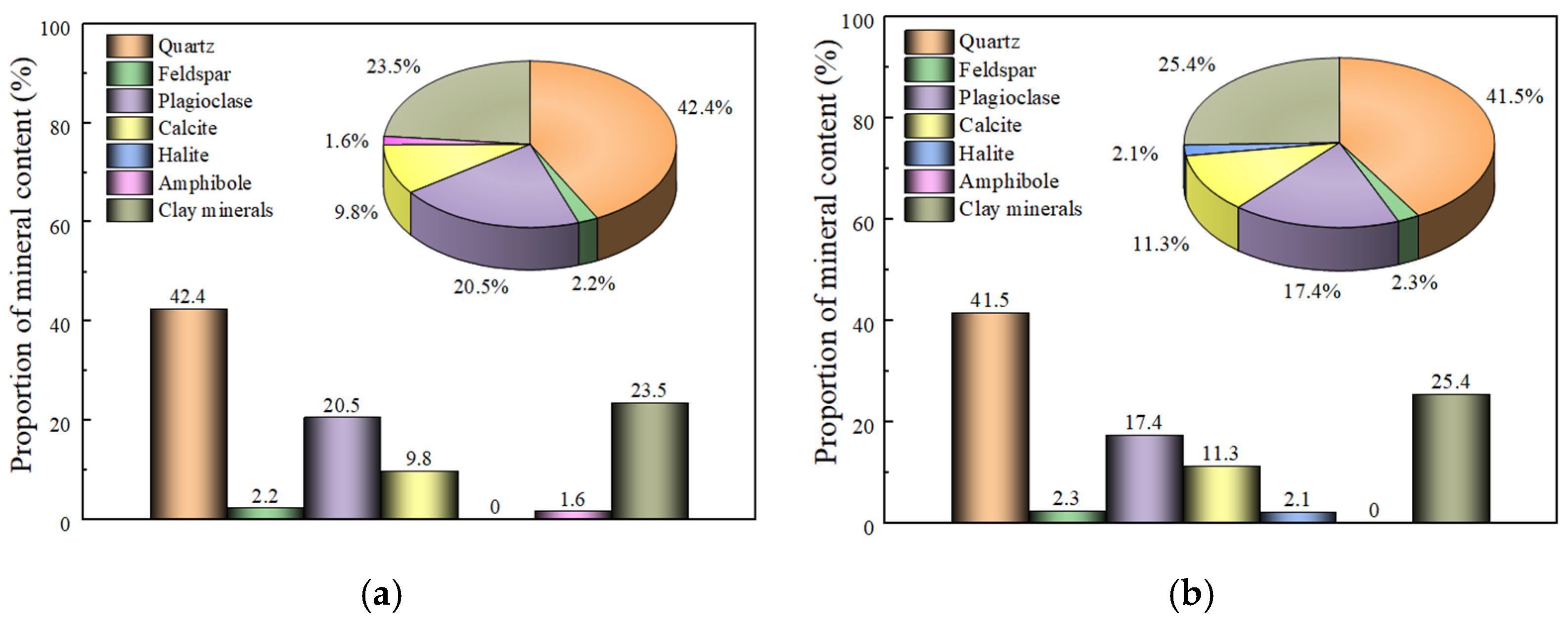


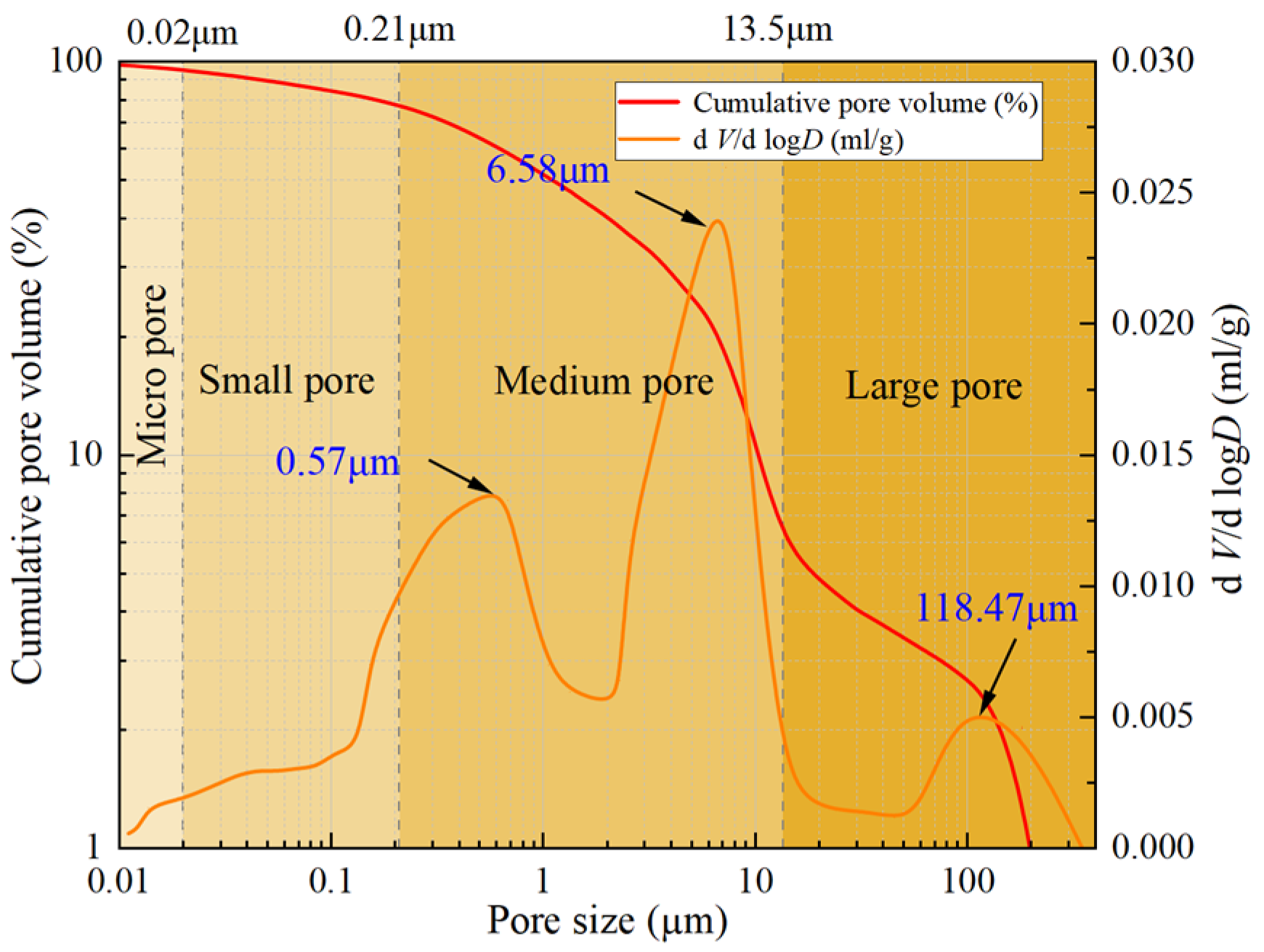
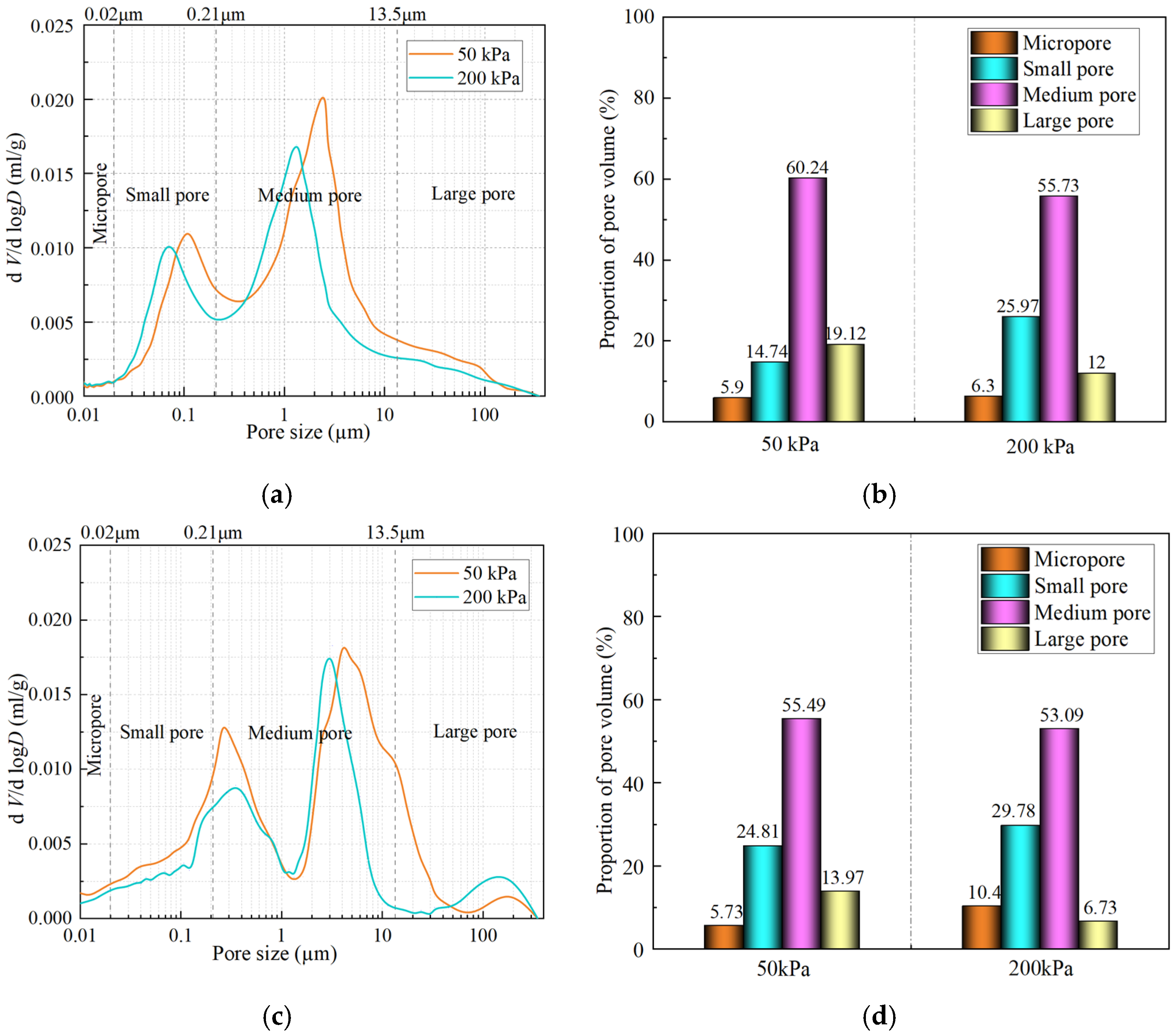

| Specific Gravity Gs | Natural Density ρ (g/cm3) | Natural Moisture Content w (%) | Dry Density ρd (g/cm3) | Maximum Dry Density ρd max (g/cm3) | Atterberg Limits (%) | Void Ratio e | Minimum Void Ratio emin | Maximum Void Ratio emax | Relative Density Dr (%) | |
|---|---|---|---|---|---|---|---|---|---|---|
| wp (%) | wL (%) | |||||||||
| 2.70 | 1.69 | 15.24 | 1.47 | 1.51 | 21.45 | 34.59 | 0.83 | 0.72 | 0.91 | 42.11 |
| Test Method | Sample Type | Sample Name | Target Moisture Content w1 (%) | Salt Content (%) | Cement Content (%) | Confining Pressure (kPa) |
|---|---|---|---|---|---|---|
| CU | Undisturbed loess | A | 15.24 | / | / | 50, 100, 200 |
| Artificial structural loess | W8-Y2.0C1.0 | 8 | 2 | 1 | ||
| W8-Y2.0C2.0 | 2 | |||||
| W8-Y2.0C4.0 | 4 | |||||
| W16-Y2.0C1.0 | 16 | 1 | ||||
| W16-Y2.0C2.0 | 2 | |||||
| W16-Y2.0C4.0 | 4 | |||||
| W24-Y2.0C1.0 | 24 | 1 | ||||
| W24-Y2.0C2.0 | 2 | |||||
| W24-Y2.0C4.0 | 4 |
| Sample Type | Sample Name | Standard Deviation σf | ||
|---|---|---|---|---|
| 50 kPa | 100 kPa | 200 kPa | ||
| Undisturbed loess | A | 0 | 0 | 0 |
| Artificial structural loess | W8-Y2.0C1.0 | 216.315 | 250.336 | 272.729 |
| W8-Y2.0C2.0 | 264.439 | 300.243 | 362.943 | |
| W8-Y2.0C4.0 | 329.803 | 366.657 | 523.901 | |
| W16-Y2.0C1.0 | 61.848 | 34.155 | 39.646 | |
| W16-Y2.0C2.0 | 6.481 | 7.676 | 4.912 | |
| W16-Y2.0C4.0 | 60.384 | 54.208 | 50.369 | |
| W24-Y2.0C1.0 | 248.556 | 242.621 | 309.983 | |
| W24-Y2.0C2.0 | 232.994 | 225.367 | 285.138 | |
| W24-Y2.0C4.0 | 207.362 | 189.434 | 233.853 | |
| Sample Type | Sample Name | Standard Deviation σf | |
|---|---|---|---|
| c (kPa) | φ (°) | ||
| Undisturbed loess | A | 0 | 0 |
| Artificial structural loess | W8-Y2.0C1.0 | 44.8 | 1.8 |
| W8-Y2.0C2.0 | 16.7 | 0.8 | |
| W8-Y2.0C4.0 | 54.2 | 3 | |
| W16-Y2.0C1.0 | 29.8 | 4.4 | |
| W16-Y2.0C2.0 | 2 | 0.2 | |
| W16-Y2.0C4.0 | 51.3 | 2.5 | |
| W24-Y2.0C1.0 | 24.2 | 6.4 | |
| W24-Y2.0C2.0 | 17.3 | 0.4 | |
| W24-Y2.0C4.0 | 46.5 | 1.3 | |
| Sample Name | Pressure (kPa) | Standard Deviation σf | |||
|---|---|---|---|---|---|
| Micropores | Small Pores | Medium Pores | Medium Pores | ||
| W16-Y2.0C2.0 | 50 | 0.17 | 10.07 | 4.75 | 5.15 |
| 200 | 4.1 | 3.81 | 2.64 | 5.27 | |
Disclaimer/Publisher’s Note: The statements, opinions and data contained in all publications are solely those of the individual author(s) and contributor(s) and not of MDPI and/or the editor(s). MDPI and/or the editor(s) disclaim responsibility for any injury to people or property resulting from any ideas, methods, instructions or products referred to in the content. |
© 2025 by the authors. Licensee MDPI, Basel, Switzerland. This article is an open access article distributed under the terms and conditions of the Creative Commons Attribution (CC BY) license (https://creativecommons.org/licenses/by/4.0/).
Share and Cite
Zhang, Y.; Qin, J.; Li, G.; Shao, M.; Gao, S. Study on the Strength Characteristics and Microscopic Structure of Artificial Structural Loess. Buildings 2025, 15, 1761. https://doi.org/10.3390/buildings15111761
Zhang Y, Qin J, Li G, Shao M, Gao S. Study on the Strength Characteristics and Microscopic Structure of Artificial Structural Loess. Buildings. 2025; 15(11):1761. https://doi.org/10.3390/buildings15111761
Chicago/Turabian StyleZhang, Yao, Jianxiang Qin, Gang Li, Minghang Shao, and Shuaifeng Gao. 2025. "Study on the Strength Characteristics and Microscopic Structure of Artificial Structural Loess" Buildings 15, no. 11: 1761. https://doi.org/10.3390/buildings15111761
APA StyleZhang, Y., Qin, J., Li, G., Shao, M., & Gao, S. (2025). Study on the Strength Characteristics and Microscopic Structure of Artificial Structural Loess. Buildings, 15(11), 1761. https://doi.org/10.3390/buildings15111761





